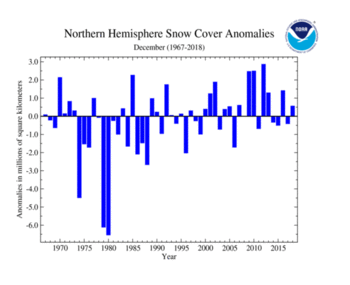NH Snow Cover Extent
| December 2018 | Snow Cover Extent | Anomaly 1991-2020 | Trend per decade | Rank (53 years) | Record | ||||||
|---|---|---|---|---|---|---|---|---|---|---|---|
| million km² | million mi² | million km² | million mi² | million km² | million mi² | Year(s) | million km² | million mi² | |||
| Northern Hemisphere | 44.55 | 17.20 | +0.28 | +0.11 | +0.37 | +0.14 | Largest | 15th | 2012 | 46.85 | 18.09 |
| Smallest | 39th | 1980 | 37.44 | 14.46 | |||||||
| North America | 16.95 | 6.54 | +0.05 | +0.02 | +0.12 | +0.05 | Largest | 21st | 2009 | 18.27 | 7.05 |
| Smallest | 33rd | 1980 | 14.56 | 5.62 | |||||||
| Eurasia | 27.59 | 10.65 | +0.23 | +0.09 | +0.26 | +0.10 | Largest | 16th | 2002 | 29.70 | 11.47 |
| Smallest | 38th | 1980 | 22.88 | 8.83 | |||||||
Data Source: Global Snow Laboratory, Rutgers University. Period of record: 1966–2018 (53 years)
The Northern Hemisphere snow cover extent (SCE) for December 2018 was 44.55 million square km (17.20 million square miles), which is 570,000 square km (220,000 square miles), or 1.29 percent, larger than the 1981–2010 average. This was 15th largest December SCE in the 53-year period of record for the Northern Hemisphere. The North American and Eurasian SCE were both slightly above average during December.
During December, the North American SCE was slightly larger than average and ranked as the 21st largest December SCE in the 53-year record. The monthly SCE was 16.95 million square km (6.55 million square miles), 100,000 square km (40,000 square miles) below average. In the U.S. above-average snow cover was observed in parts of the Northeast, the Rockies while in Canada above-average snow cover was observed in the Rockies and Great Lakes region. Below-average snow cover was observed across much of the Midwest. The contiguous U.S. SCE was below average, while the Canadian SCE ranked as the 12th highest for the month. The Alaska SCE tied as the seventh highest on record.
The Eurasian December SCE was 27.59 million square km (10.65 million square miles), 460,000 square km (180,000 square miles) above average and ranked as the 16th largest December SCE on record. Above-average snow cover was observed across parts of northern and eastern Europe, Kazakhstan, Uzbekistan, and across much of China. Below-average snow cover was observed across much of northern China and Mongolia, parts of the Middle East, and western Europe.
Sea Ice Extent
| December 2018 | Sea Ice Extent | Anomaly 1991-2020 | Trend per decade | Rank (40 years) | Record | ||||
|---|---|---|---|---|---|---|---|---|---|
| million km² | million mi² | Year(s) | million km² | million mi² | |||||
| Northern Hemisphere | 11.86 | 4.58 | -4.35% | -3.71% | Largest | 36th | 1982 | 13.64 | 5.27 |
| Smallest | 4th | 2016 | 11.46 | 4.42 | |||||
| Southern Hemisphere | 9.19 | 3.55 | -11.63% | +0.96% | Largest | 38th | 2007 | 11.98 | 4.63 |
| Smallest | 2nd | 2016 | 8.28 | 3.20 | |||||
| Globe | 21.05 | 8.13 | -7.72% | -1.58% | Largest | 38th | 1988 | 24.69 | 9.53 |
| Smallest | 2nd | 2016 | 19.74 | 7.62 | |||||
Data Source: National Snow and Ice Data Center (NSIDC). Period of record: 1979–2018 (40 years)
According to the National Snow and Ice Data Center (NSIDC), the Northern Hemisphere (Arctic) sea ice extent — which is measured from passive microwave instruments onboard NOAA satellites — averaged for December 2018 was 11.86 million square km (4.58 million square miles), 980,000 square km (378,000 square miles), or 7.6 percent, below the 1981–2010 average. This was the fourth smallest December sea ice extent on record for the Arctic, behind 2016, 2017, and 2010. At the end of December, below-average sea ice was observed in the Kara and Barents Seas with near-average ice across the other regions.
The December Southern Hemisphere sea ice extent was 9.03 million square km (3.49 million square miles), which was 1.38 million square km (530,000 square miles), or 13.3 percent, below the 1981–2010 average. This was the second smallest December Antarctic sea ice extent on record, trailing behind 2016. Southern Hemisphere sea ice extent is increasing at an average rate of 1.5 percent per decade.
For further information on the Northern and Southern Hemisphere snow and ice conditions, please visit the NSIDC News page.
 NOAA's National Centers for Environmental Information
NOAA's National Centers for Environmental Information




